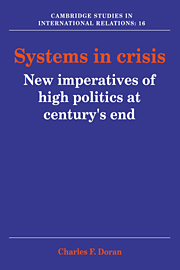Book contents
- Frontmatter
- Contents
- Preface
- Acknowledgments
- Introduction: new perspectives on the causes and management of systems crisis
- Part 1 Dynamics of state power and role: systems structure
- Part 2 Dynamics of major war and systems transformation
- 4 Critical intervals on the power cycle: why wars become major
- 5 Systemic disequilibrium and world war
- Part 3 Dynamics of general equilibrium and world order
- Part 4 Systems transformation and world order at century's end
- Appendix: Mathematical relations in the power cycle
- References
- Index
5 - Systemic disequilibrium and world war
Published online by Cambridge University Press: 08 September 2009
- Frontmatter
- Contents
- Preface
- Acknowledgments
- Introduction: new perspectives on the causes and management of systems crisis
- Part 1 Dynamics of state power and role: systems structure
- Part 2 Dynamics of major war and systems transformation
- 4 Critical intervals on the power cycle: why wars become major
- 5 Systemic disequilibrium and world war
- Part 3 Dynamics of general equilibrium and world order
- Part 4 Systems transformation and world order at century's end
- Appendix: Mathematical relations in the power cycle
- References
- Index
Summary
Changes in the interacting state units and changing systemic structure are inseparable (albeit different) aspects of a single structural dynamic. Here the systemic perspective provides a focus on historical and contemporary statecraft needed for articulation of general equilibrium.
STATE VERSUS SYSTEM AS A SOURCE OF CONFLICT EXPLANATION
Chapter 4 explored the relationship between the critical intervals on an individual actor's power cycle and the wars which that actor initiated. In this sense, the causation was direct, explicit, and one-to-one (albeit, as well, highly restrictive). To shift to a systems perspective regarding the origins of major war is to adopt the focus of the other actors with which the potentially disruptive actor must deal.
In strictly a negative sense, the old Rousseauian adage is true relating the decentralized nation–state system and conflict: wars happen because there is nothing to stop them, or despite efforts to stop them. If the individual state is the initiator of a conflict, the system is that which has permitted it to happen. The system can act with complicity or in opposition. It can strengthen or dampen the urge to use violence. It can create a setting in which expansionism is easy and encouraged or in which the use of force either is not sought or is unproductive. At the very least, the system determines the nature of the response to aggression. But the system may also be a catalyst or a direct cause of major war.
- Type
- Chapter
- Information
- Systems in CrisisNew Imperatives of High Politics at Century's End, pp. 117 - 140Publisher: Cambridge University PressPrint publication year: 1991



